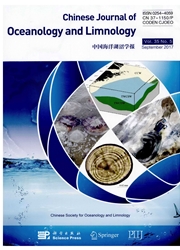

 中文摘要:
中文摘要:
在这篇论文,我们使用在强迫的变化 seasonally 的观察数据和一个三维的海洋模型回答在华东海(ECS ) 在 PN 节学习障碍层(BL ) 的 conductivity-temperature-depth (CTD ) 。BL 能与显然季节的可变性沿着 PN 节被发现。在冬季,春天和秋天, BL 在冷架水遇到温暖的自台湾东面的菲律宾海流向日本的暖流水的斜坡附近发生。在夏天, BL 能也在 Changjiang (Yangtze ) 河冲淡水(YRDW ) 的咸度前面附近在架区域被发现。在 PN 节的 BL 的季节的变化被本地水文学特征和大气的强迫的季节的变化引起。海运引起冷却的表面的强壮的垂直传送对流变厚在冬季的 BL 和在斜坡区域的春天。由于在夏天的 Changjiang 河的大分泌物, BL 在新鲜 YRDW 和咸底部水在季节的 thermocline 上面遇见并且形成强壮的 halocline 的架区域广泛地发生。在 PN 节的 BL 的形成机制能被解释由垂直不同的水群众砍,它被称为移流机制。内部在夏天的 BL 的年度变化被 YRDW 极大地影响。在更大的 YRDW 年里(例如 1998 ) ,浅却厚得多的 BL 在架区域上存在。
 英文摘要:
英文摘要:
In this paper, we use the conductivity-temperature-depth (CTD) observation data and a three-dimensional ocean model in a seasonally-varying forcing field to study the barrier layer (BL) in the PN section in the East China Sea (ECS). The BL can be found along the PN section with obviously seasonal variability. In winter, spring and autumn, the BL occurs around the slope where the cold shelf water meets with the warm Kuroshio water. In summer, the BL can also be found in the shelf area near salinity front of the Changjiang (Yangtze) River Dilution Water (YRDW). Seasonal variations of BL in the PN section are caused by local hydrological characteristics and seasonal variations of atmospheric forcing. Strong vertical convection caused by sea surface cooling thickens the BL in winter and spring in the slope area. Due to the large discharge of Changjiang River in summer, the BL occurs extensively in the shelf region where the fresh YRDW and the salty bottom water meet and form a strong halocline above the seasonal thermocline. The formation mechanism of BL in the PN section can be explained by the vertical shear of different water masses, which is called the advection mechanism. The interannual variation of BL in summer is greatly affected by the YRDW. In the larger YRDW year (such as 1998), a shallow but much thicker BL existed on the shelf area.
 同期刊论文项目
同期刊论文项目
 同项目期刊论文
同项目期刊论文
 期刊信息
期刊信息
